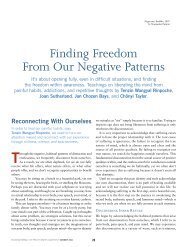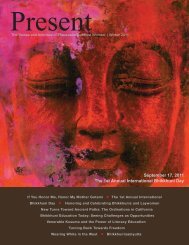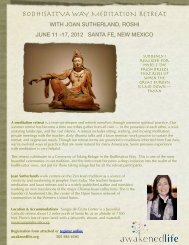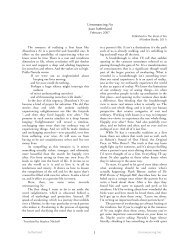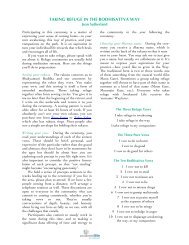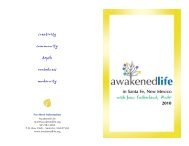Rakusu Instructions - Awakened Life
Rakusu Instructions - Awakened Life
Rakusu Instructions - Awakened Life
Create successful ePaper yourself
Turn your PDF publications into a flip-book with our unique Google optimized e-Paper software.
MAKING A RAKUSU<br />
Your rakusu is an intricate and individual piece of work and should be made without rushing. Please<br />
allow plenty of time (30-40 hours) to enjoy making it, particularly if you’re not accustomed to<br />
sewing. It’s helpful to have a finished rakusu in front of you while you work. Read all instructions<br />
carefully before you begin. There's a glossary of sewing terms at the end.<br />
You will need :<br />
1¼ yds of dark cloth *<br />
½ yd of white cloth **<br />
½ yd of black non-fusible interfacing<br />
1 ring of a material like wood, 2¼" –<br />
2¾" in diameter ***<br />
1 length of green embroidery thread<br />
3<br />
Large cutting mat (24" x 36")<br />
Rotary cutter<br />
Large transparent measuring square<br />
White chalk or pencil and chalk wheel<br />
for marking on fabric<br />
* The dark cloth can be black, brown, grey, or navy blue—a color representing the dark earth.<br />
Medium-weight cotton is the easiest to work with, but any fabric is fine. Pre-wash before you begin<br />
sewing in case the fabric shrinks. If you already have fabric that’s meaningful to you in some way<br />
you can dye it a dark color and use that.<br />
** Tightly woven, shiny silk with some weight to it is the best fabric to write on. Whatever fabric<br />
you choose, the tighter the weave and the smoother the surface the better.<br />
*** Make your own, or buy one on the Zabu Zabu website.<br />
1. Using white chalk or a sharp white pencil, accurately mark all pattern pieces along the straight<br />
grain of the fabric (parallel to the selvages); don't include the selvage in any of the pieces.<br />
Double check before cutting anything. There are patterns for pieces A-D in Appendix C; for the<br />
rest, use the measurements below. You'll end up with 16 pieces of dark cloth, 2 pieces of white<br />
cloth, and 2 pieces of interfacing. Always use the straight grain of the fabric.<br />
ON DARK CLOTH :<br />
1 each of A 1 & A 2 , 11" x 3"<br />
4 of B, 9" x 1½"<br />
2 of C, 10" x 1"<br />
1 of D, 10" x 3"<br />
1 of E, 36" x 4½"<br />
1 of F, 14½" x 4½"<br />
1 of G, 9" x 2¼"<br />
1 each of H & J, 42" (for small person)<br />
to 46" (for large person) x 4½"*<br />
1 each of K & L, 10" x 4½"<br />
ON WHITE CLOTH :<br />
1 of O, 10" x 4"<br />
1 of P, 12½" x 9"<br />
ON INTERFACING :<br />
1 of M, 15½" x 11½"<br />
1 of N, 10" x 4½"<br />
* These are the straps, which go from one side of<br />
the rakusu, across the back of your neck, to the<br />
other side. Measure to find approximately the<br />
right length for you; you’ll have a chance to<br />
shorten them later if necessary.



